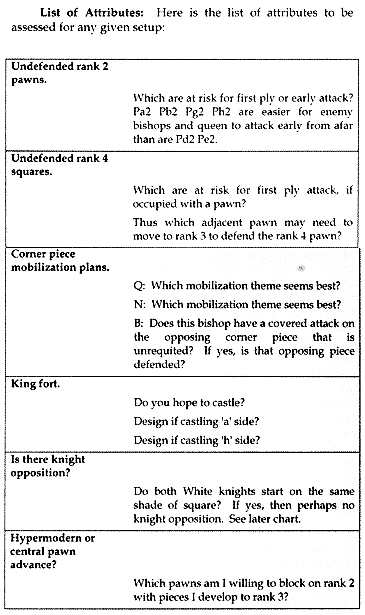The first four chapters of part two deal with the four phases of a chess game. 'Four phases?', I can hear you ask. In Milener's own words (p.108),
There are four phases to any chess game. Phases two through four are well known as the opening, the middle game, and the endgame. We have never before called it by a name, but I call the first phase the setup phase.
He goes on to explain,
In the chess1 realm the setup phase has not been recognized as a phase at all. This is because the chess1 setup never varies the way it does in chess960. In chess1 we instead talk about opening "theory", referring to the accumulation of at-home pre-game calculation and analysis of the chess1 setup position.
As part of the chess1 setup phase we also have the devised opening principles given by Aron Nimzovich in his My System, which was also written at home. The setup phase is different in chess960. Yes, there can be at-home thought and preparations as part of the chess960 setup phase (as this book should demonstrate). But in chess960 the setup phase comes alive and requires original thought in real time, in the several minutes after the pieces are set but before the clocks are started. This chapter is devoted to the topic of handling those pre-game minutes.
Where Milener writes 'chess1', I prefer to use the notation 'SP518' (meaning start position 'RNBQKBNR'). It's not a terribly important distinction, but it does reinforce the idea that traditional chess is a subset of chess960. What is important is the recognition that there is a distinct phase to a chess game called the 'setup phase'. Until now, the setup phase was usually something like this:-
Exercise: Place all 32 chess pieces into a bag or a box. Shake thoroughly. Dump all of the pieces on to the board. How fast can you place them on their traditional SP518 squares?
The title of the first chapter in Milener's part two is 'Strategies for the Modified Setup Phase'. In other words, how do we go from a random chess960 start position to playing the first move for White in that position? Milener starts with a question: 'Do the Chess1 Opening Principles of Nimzovich Remain True for Chess960?' Instead of analyzing Nimzovich, he quickly switches to Reuben Fine, an author I've also referenced at various times in the past. Milener's answer to 'Do the Opening Principles Remain True?' is a solid yes-and-no.
The next section is 'Rationalization of Setups: How?' By 'rationalization', I understand 'classification' or 'categorization' of the 960 setups into a smaller number of positions having common characteristics. I discussed this recently with an email correspondent, where I wrote,
The problem is that given an obvious similarity -- Bishops in the four corners (to use a well known example) -- the tactics++ depend on how the other pieces are initially placed. Then you start to analyze each position individually, which defeats the purpose of the exercise.
Milener apparently agrees and his suggestions boil down to something like my post, A Framework for Chess960 Opening Theory (April 2009). It appears to be the only sensible direction to make further progress.
After the initial discovery of the setup phase, the most important section of the setup chapter is probably 'List of Setup Attributes'. I've copied the section's central table (p.119-120) into the following image.

While I don't necessarily agree with these six choices -- 'Is there Knight opposition?' is far less important than 'King fort' -- they nevertheless provide a basis for further discussion. I particularly like the inclusion of 'Corner piece mobilization'. In SP518, the corners are conveniently occupied by the piece which is best suited for that square, the Rook. The other three pieces face challenges to their development from the corner which are not present in their development from other start squares.
Coming back to the world of traditional chess as we know it, the 2018 World Championship is currently underway. Before any moves were played in the match, the two players, GMs Carlsen and Caruana, spent many months working on the setup phase, although no one called it that. It is called instead 'opening preparation'. In traditional chess, it's a phase where psychology plays the dominant role.
The next chapter in Milener's book, 'From Setup Attributes to Opening Moves', covers what happens after White's first move is played. Gene Milener deserves credit for being the first chess960 adherent to work through the most important difference between traditional chess and chess960 : a previously unknown phase.

No comments:
Post a Comment